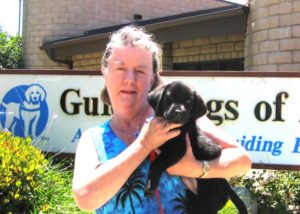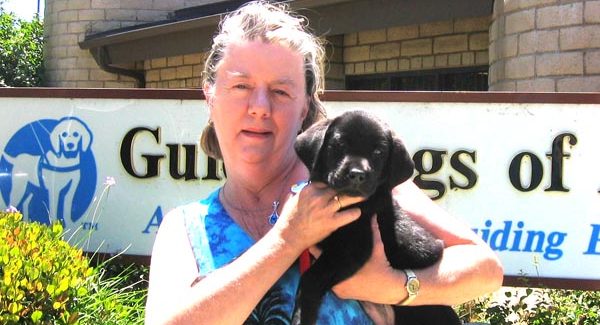Guide Dog Graduations Offer
Glimpse of America at its Best
by
Graduations are joyous events. For students with newly learned skills, they mark the beginning of lives as independent adults. At Guide Dog schools around the country the ceremonies are even more emotional since there they celebrate, not only the hard won mobility of the blind, but also the dedication of the animals that will guide them through a more meaningful life.
When time came for Lorita Betraun to receive her diploma from Guide Dogs of America one sunny day recently in Los Angeles, she stood and gently moved her cane toward a black Labrador named Valor sitting at her feet.
“Valor and I have grown very close over the past few weeks,” she said, her voice cracking with emotion. “He is my sight, my light, my friend. Truly, Valor is my key to the city.”
When Betraun finished her remarks the man sitting next to her rose slowly and recounted his experiences raising the dog as a puppy. “Valor came to our family as a little fur ball but now he’s grown up and has a real companion in Lorita,” he said, wiping a tear from his eye. “People ask me how I could ever give him up. But I think about the great mission to which he is called and say how could I not.”
There are more than a dozen guide dog schools across America. Most of them have public tours and graduations throughout the year. And judging by the recent scene at Guide Dogs of America’s seven-acre campus and kennel complex in north Los Angeles the ceremonies are a portrait of Norman Rockwell America where Girl Scouts still lead the Pledge of Allegiance, busloads of senior citizens are welcomed for the day and volunteer puppy raisers who call themselves “foster parents” bring young Labradors, Golden Retrievers, German Shepherds and Poodle mixes to accustom them to crowds.

Texan Melissa Daniels will leave her estate to GDA
“This is a rewarding charity deserving of my support,” said Melisia Dennis, who flew in from Amarillo for the graduation with the intention of leaving her estate to GDA. “My mother died last month after suffering from macular degeneration. I have five dogs and I don’t think I could give any of them up. But I can rewrite my will to leave this place money.”
The first guide dog training schools were established in Germany after World War I to enhance the mobility of returning veterans blinded in combat. A wealthy Philadelphian named Dorothy Eustis living in Switzerland thought the German Shepherds she was raising could serve as guide dogs and gave $10,000 to start The Seeing Eye in Nashville, TN. In 1942 Guide Dogs for the Blind opened in San Rafael, CA to aid veterans blinded in World War II. Six years later, Guide Dogs of America opened with support from the International Association of Machinists & Aerospace Workers when it became clear that some organizations were denying dogs to blind people who were elderly.
All of the leading guide dog programs in the U.S. are non-profit charitable organizations supported by donations from individuals, businesses, civic organizations and bequests. Visually impaired people can petition for a dog and, if approved, be flown to a school free of charge where they receive complimentary room and board while being matched with a dog of appropriate size and temperament.
Training given to a dog is more prolonged and intense than that accorded its eventual owner. After being acclimated to all the environments they likely will encounter, dogs are taught to ignore strangers, resist distractions like bacon and exhibit “intelligent disobedience” when ordered into an unsafe situation.
It costs GDA about $38,000 to raise, train and pair a guide dog with a blind recipient. Of that amount, $19,000 is just the cost of the dog.
Not all dogs make it to graduation. Dogs that are too friendly or get distracted while in harness often go into search and rescue. Those that are overly inquisitive end up working for Homeland Security as bomb and drug sniffers. “We call these ‘career change dogs,’” says Joanne Ritter, marketing director for Guide Dogs for the Blind.

Goldendoodles make great guide dogs
But when a blind person is introduced to the right dog the result can be life changing. Just ask J.C. Clark of Plano, TX, a former Dallas police officer who began losing his sight due to a degenerative condition in 1992 while working as a Collin County deputy sheriff.
“I lost my career at age 51, but it wasn’t until 1999 that I went to Guiding Eyes for the Blind in New York State to get a guide dog,” says Clark. “There were 12 people in the class and we spent 26 days at the school working 16 hours a day going through every possible situation that we might encounter in life.”
Today, Clark and his guide dog “Gilroy” often travel by themselves to Houston after taking public transit out to DFW airport. When staying at hotels the dog takes Clark directly to the elevator call button, then to the right room on the appropriate floor.
“Last year, my wife and I flew to San Diego and while there visited some museums in Balboa Park,” Clark remembers. “We came out through a different exit and had no idea where we parked the rental car, but Gilroy went directly to the correct parking lot and found the car he’d been in only once. There’s no way to put in words what a guide dog can do for a person without sight.”
What Breeds Are Best
Guide dogs are bred to lead the blind. They must be strong enough to work in harness, yet small enough to fit beneath an airplane seat. Great Danes and terriers are disqualified by their size. Beagles are temperamentally unsuited to the task. Spaniels require excessive maintenance and are prone to eye problems. The following breeds, however, are suited to the task.
Labrador: Multiple varieties within the breed allow Labs to be bred to meet the specific needs of individual users. Labs retain their training and temperament if owners change.
Golden Retriever: Mid-sized dog with intelligence and loyalty. Retains its focus on work amid the distractions of urban life.
German Shepherd: Classic military work dog was first to be used for guiding the blind. Susceptibility to hip dysplasia is the breed’s only weakness.
Poodle: People with allergies appreciate a work dog that doesn’t shed. Downside: poodles require regular grooming.
Goldendoodles, Labradoodles: Pure breeds tend to make the best guide dogs, but these two cross breeds are increasing in popularity.
East-West News Service editor David DeVoss has a Chow-Retriever mix named Homer.


